Golf Course
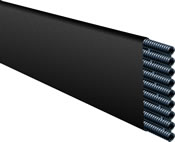
Typical vertical installations
Because Multi-Flow is typically installed in a 4 inch wide trench, it is conveniently installed vertically wherever trenching is required. In new construction but even more importantly in remedial settings, the amount of spoil that needs to be hauled away and the amount of backfill that needs to be carried back in are important factors in determining time and cost. Furthermore, in remedial settings, the reduced scarring is also an attractive benefit of Multi-Flow.
Fairways – Single trunk lines running the length of a fairway or just through low areas can provide effective drainage. Spurs off the left or right or both into low-lying areas adds effectiveness.
Cart paths – When a cart path acts as a barrier to normal water movement from a higher to lower area, a Multi-Flow line can act as an escape route for water. In low lying areas, Multi-Flow collector lines on both sides of the path can prevent the saturation and deterioration of the path base.
Bunkers – Trenching Multi-Flow into the bunker base places it out of reach of maintenance equipment. An intensive pattern provides even and prompt drainage without encouraging the migration of bunker sand during heavy rain events.
Other – Single vertical runs of Multi-Flow are often the best solution to soggy areas in tees, roughs, flower beds, and transition areas.
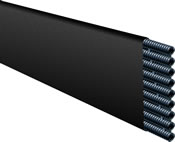
Typical horizontal applications
In settings where all of the soil has been temporarily removed, exposing a clay base, no trenching is needed. Multi-Flow can simply be rolled out and installed horizontally. Recent research by Dr. Ed McCoy at Ohio State University has demonstrated that this trenchless system provides drainage effectiveness similar to trenched systems without the extra time and expense involved.
Greens – Greens are most effectively drained with an intensive pattern. This produces two desired effects: excess water is removed quickly and minimal migration of soil particles occurs. When drain lines are distributed throughout the green, water simply moves straight down. Water that moves gently and a minimal distance is less likely to dislodge soil particles. This exposes the drainage system to less danger of blockage.
Bunkers – A similar pattern is sometimes utilized in bunkers if the bunker has a wide flat bottom. Frequently bunkers require substantial drainage capacity because surrounding greens or fairways slope toward them.
Four reasons for using Multi-Flow on your course
Whether it is new course construction or the renovation of an existing course, Multi-Flow is a wise choice because Multi-Flow is 1) easy to use 2) long lasting 3) highly efficient 4) cost effective.
1. Easy to use – At least three factors make Multi-Flow a product that designers, contractors, and superintendents love to work with:
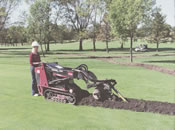
Shape – Because of its panel shape, Multi-Flow can be inserted vertically in a narrow trench or laid out horizontally, without trenching. Either way, it is a great time saver. Vertical installations in a narrow trench are common in fairways. Horizontal installations are common in greens.
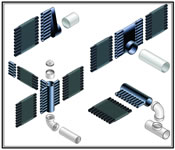
Connectors – Not only are Multi-Flow connectors easy to use, there are a lot of them. Any configuration that is appropriate for a given site can be carried out using one or more of the 60 Multi-Flow connectors.
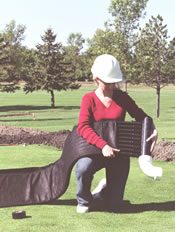
Flexibility – Multi-Flow is highly flexible making it convenient to work with, suitable for making tight turns, and easily joined to connectors.
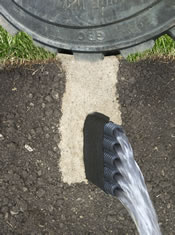
2. Long lasting – Multi-Flow enjoys longevity because of:
Strength – Multi-Flow is designed to withstand heavy loads. Able to withstand loads well in excess of 6,000 psf, Multi-Flow is not going to collapse due to heavy surface loads in shallow installations or due to earth weight in deep installations. Heavy trucks and equipment are rare on courses but when they do venture out they can cause significant damage. One trip with a dump truck across a shallow collector line can render the line useless. Multi-Flow can withstand this kind of abuse.
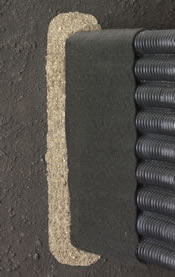
Compatibility with BMP installation techniques – The Multi-Flow system includes a heavy effective geotextile filter. This high quality fabric acts as an excellent secondary filter, keeping Multi-Flow’s flow channels clean and open. Clean coarse sand acts as a very effective primary filter. Due to its shape, Multi-Flow is easily encased in sand, assuring a long life. When placed in a 4 inch wide trench Multi-Flow is readily protected in this way. This would be difficult if not impossible using French drain methodology.

3. Highly efficient – Golf course drainage systems must be able to collect and transport water. Multi-Flow excels in both regards:
Water can enter a Multi-Flow drain more readily because Multi-Flow has greater surface area than traditional round pipe. The more drainage product that is in contact with surrounding saturated soil, the more quickly drainage can take place. A foot of 12-inch Multi-Flow provides 312 square inches of collection area while a 4-inch round pipe offers less than half that amount, 150 square inches
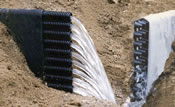
Once water has entered Multi-Flow flow channels, it moves away quickly because the channels are round and unobstructed, in contrast to other panel shaped drains.
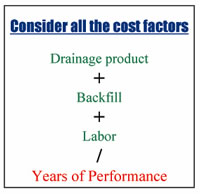
A completed Multi-Flow system typically costs about half the total of a comparable French drain system. Add to that its longer life and Multi-Flow begins to look very attractive! Now factor in the cost of tee times and disgruntled customers and it is a system you cannot afford to live without!

